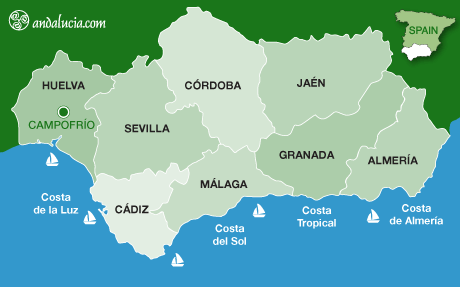Campofrio
by Saskia Mier
Campofrio is situated within the Comarca Minera (mining area) of El Andevalo and is said to have one of the oldest bullrings in Spain dating back to 1716. It has around 800 inhabitants.
HISTORY
Among the abundant archaeological remains found in Campofrio are several graves, ruins of houses and even a water tank in the Cerro de los Cobullos, suggesting a settlement during the late Bronze Age.
It is believed that the fortress was built by King Solomon, seduced by the breath-taking metallurgical wealth of the area, as described by Father Juan Pineda in 1609 in his work Historia de Rey Salomón.
Campofrio also has remains of the Roman road that joined the mines of Rio Tinto with Emérita Augusta, crossing the Rio Odiel via a magnificent bridge that still stands today, as well as graves and a necropolis in Risco del Tesoro. Coins from the Trajan and Hadrian era have also been discovered here. Other archaeological remains from the same era were unearthed in the natural rest stops of Guerro, El Majuelo and Valdelahiguera.
During the Moorish era, Campofrio depended on Niebla and Alájar, later altered by Alfonso X during the mid-13thcentury.
Data referring to the existence of Campofrio suggests the village belonged to Aracena in the late Middle Ages, around the early 15th century.
After centuries of territorial disputes, Campofrio was given independence in 1753, thanks to a royal privilege granted by Fernando VI.
From the second half of the 19th century Campofrio was strongly linked to the manganese mines of Cobullos and La Ponderosa, thanks to the new British owners.
THINGS TO SEE
Iglesia Parroquial de San Miguel
The church of San Miguel Arcángel dates back to the 15th and 16th centuries. It was completely restored, with late Baroque style in the late 18th century and construction was completed in 1791. Located in Plaza de la Constitucion.
Plaza de Toros
The bullring of Campofrio was built by the brotherhood of Santiago Apóstol from 1716 to 1718 and is considered to be one of the oldest in Spain. It was inaugurated in 1718, restored in 1936, and later re-inaugurated in 1977 using steers from San Patricio, fought by the well-known bullfighters, Litri, Antonio Borrero Chamaco and Niño de la Isla. The bullring has a capacity of 1,500 spectators, and is always used on 25 July during the annual festival in honour of Santiago Apóstol. In 2002 the composer, Rafael Prado, composed and premiered the pasodoble 'Campofrio', dedicated to the bullring. It is also one of the largest bullrings, with a diameter of 53,3m behind Las Ventas in Madrid witjh 61.5m, Ronda with 66m and la Real Maestranza de Sevilla. Located west of Campofrio, off the HV-5021.
Puente Viejo
Sadly "Old Bridge" is in very bad condition today, but it is one of the most outstanding examples of civil constructions built on a large central pillar with two arches on either side: one, where the Rio Odiel flows, and the other, smaller, originally carried flood water. Although it was considered of Roman origin, recent studies date it to the Middle Ages, during the 14th and 15th centuries. According to archaeologist, Juan Aurelio Perez Macias, it was constructed due to the importance of the quarries of Cerro de Cobullos during the reign of Felipe II. A solid structure to cross the river was needed for heavy ox carts heading towards Aracena, from where the mining produce was distributed to other parts of the Peninsula. Located about 3.7km north-northwest of Campofrio.
Hotels near Campofrio
Book Hotels near Campofrio
GASTRONOMY
The gastronomy of Campofrio includes dishes such as ajopuchero, Iberican pork and cocido serrano (pork stew). As for sweet treats, polea (somola), torrijas (eggy bread dipped in honey), dulces de castaña (chestnut pastries) and hojuelas (pastries dipped in honey).
HANDICRAFTS
Local handicrafts include products made from wood and cork, obtaining intricately carved spoons and other utensils. Pottery also has a deep tradition in Campofrio.
FESTIVALS
Viernes de Dolores
Celebrated during Holy Week, residents travel to the holy cross of Dolores to pray to the Virgin and lay flowers.
Fiesta Gastronómica y Cultural
The festival aims to show the ritual of the traditional pig slaughter and homemade products that are made during this time. Visitors can enjoy the many samples and tastings that are served free.
Dia de la Villa
Celebrated the first weekend of May, the church square is filled stands containing ceramics, sweets, sausages, hams, charcuterie and cheeses. A great garbanzada with cod and sausage is made for all visitors free of charge.
Romeria de Ventas Arriba
The pilgrimage is celebrated one week before Corpus Christi.
Fiesta de Santiago Apostól
Celebrated on the 25 July in honour of the saint. The celebration lasts 5 days with all kinds of music and cultural events, including a bullfight.
Romeria Reina de los Ángeles
The pilgrimage is celebrated on the 8 September where the saint is moved from Campofrio to the Peña de Arias Montano.
Fiesta de Santa Bárbara
On the night of 4 December, a procession of the patron saint of miners is taken through the streets and the night ends with a music celebration.
Fiestas de la Inmaculada Concepción
The celebration starts on the 7 December with the traditional candelas, great bonfires in the streets accompanied by songs and dancing. The next day, 8 December, after mass a great feast is celebrated to make way for a procession that night.
LOCATION
Campofrio is located 81km from Huelva. To get there, take the H-31 leaving Huelva and take Exit 75 towards Trigueros. Pass Trigueros, Beas, Valverde del Camino and Zalamea la Real. After Zalamea la Real, turn right on to the A-461. Continue on passing El Campillo and Minas de Rio Tinto until you reach Campofrio.
